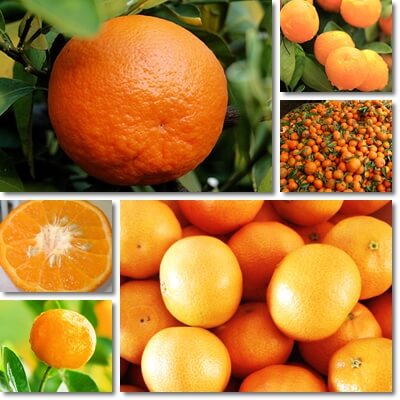Tangerines are hybrids of the mandarin orange and pomelo with a bright orange rind and an equally colorful flesh. Tangerines are highly fragrant and sweet, with juicy flesh and a rind that peels off easily. The citrus variety is high in vitamin C, but otherwise modestly nutritious. However, eating tangerines is good for anemia and diabetes and provides benefits for high blood pressure and high cholesterol, as well as anti-inflammatory and anti-aging benefits.
What are tangerines?
Tangerines are a type of mandarin orange, more exactly, mandarin orange hybrids. Tangerines are a result of the hybridization between a mandarin orange and the pomelo, two original citrus fruit. The name tangerine refers to not one citrus variety, but several. However, there isn’t a clear consensus on exactly how many tangerine varieties there are since different citrus classification systems propose different numbers. The difference between tangerine varieties is primarily the ratio of mandarin to pomelo, that is, how much mandarin vs pomelo ancestry. Some tangerine varieties are quite similar genetically speaking, except for characteristics such as resistance to certain diseases. Tangerines that hybridize with pomelo or grapefruit produce citrus crosses called tangelos.

In some parts of the world, especially in commercial settings, tangerines are classified based on looks rather than genetics. For example, tangors, which are crosses between the mandarin and the sweet orange, are called tangerines and marketed as such simply because they look like tangerines. In fact, tangerines are often considered to be one of the many different types of oranges, despite not being actual oranges.
Botanically speaking, tangerines are referred to as either Citrus reticulata, the same scientific name used for the mandarin, or as Citrus tangerina, a scientific name that identifies tangerines as an individual species rather than an obscure citrus cross. Tangerines are in season roughly fall through spring.
What do tangerines look like?
The typical tangerine look is that of a small or medium-sized orange-like fruit with a bright orange to reddish-orange rind that is fairly easy to peel. Tangerines are somewhat flattened at the poles, and some cultivars may look slightly deflated. The rind presents with tiny indentations, but is fairly thin and highly aromatic. The flesh is bright orange and glossy, separated in segments with rounded edges, covered by a thin peel. Tangerines are extremely juicy and may be seedless or with seeds (hard white pips). There is very little of the bitter white spongy pith on the inside of the rind which is what makes tangerines so easy to peel. The citrus fruit are often sold with stems and leaves.
What do tangerines taste and smell like?
The typical tangerine is extremely aromatic, with a strong and sweet, citrussy smell. The bright orange flesh is juicy and glossy, with a pregnant sweet taste and low acidity. Tangerines have a stronger taste and flavor profile compared to sweet oranges and are ideal for eating raw, as they are, or incorporated into various dishes. The citrus fruit is also great for juicing, yielding lots of sweet, fragrant juice.
Oils extracted from tangerine rind may be used to add fragrance to perfumes, cosmetics and skin care products. The peel may be candied, used for making marmalade or as a flavoring for baked goods and desserts in general. You can also make tea from tangerine peels and juice using the same recipes as for home-made orange tea.

Tangerines nutritional information
Tangerines have relatively poor nutritional value, with the exception of a generous vitamin C content of over 30% of daily recommended intakes per 100 g of raw fruit. Other notable essential vitamins and minerals in tangerines include vitamin B6 (6% of RDI, recommended daily intake for an average adult), vitamin B1 (5%), vitamins B5, B9 and A, calcium and potassium (4%), vitamins B2, B3, magnesium and phosphorus (3%).
Tangerines are almost sodium-free and contain trace amounts of vitamin E, manganese, iron and zinc. Tangerines have over 50 kcal per 100 g and over 13 g of carbs, of which about 10.5 g natural sugars and 1.8 g dietary fiber.
Benefits of tangerines
Good food for weight loss
If you are looking to lose some weight, then tangerines are a good food to include in your diet for healthy weight loss. Tangerines have only about 50 kcal per 100 g, and are extremely low in fat, but a source of essential vitamins, minerals and antioxidants.
Minor benefits for constipation
Tangerines have 1.8 g of dietary fiber per 100 g and help regulate transit and relieve constipation naturally. Eating the flesh, peel around the fruit segments, and some pith strands can add to the fiber intake.
Good food to eat for nausea, vomiting and diarrhea
If you’ve been vomiting or experiencing diarrhea, then tangerines are a good food to consider because they are high in water and can help restore fluids lost through vomiting and diarrhea. Tangerines also provide small and trace amounts of several minerals and contribute to electrolyte balance, and natural sugars to raise energy levels.
Anti-inflammatory properties
The anti-inflammatory properties of tangerines are owed primarily to the fruit’s vitamin C content. Vitamin C is scientifically proven to lower levels of several inflammation markers in the body, such as C-reactive protein, and help reduce inflammation. Tangerines also contain a flavonone called hesperidin which studies show exerts anti-inflammatory effects (source). Hesperidin is found in the spongy white part of citrus fruit, also known as albedo or pith, as well as juice and even rind.
Natural antibacterial and antiviral properties
Vitamin C occurs naturally in tangerines, flesh and juice, and is a source of antibacterial and antiviral effects, and even exerts an antifungal action. Antioxidants such as naringenin and other flavanones and bioactive compounds in the fruit flesh, juice and pith also exert antibacterial, antiviral and antifungal effects. Tangerine rind is a source of aromatic volatile organic compounds with an antimicrobial and antifungal action.
Anti-aging benefits and benefits for skin
The good amount of vitamin C in tangerines stimulates collagen production in the skin for better skin elasticity and fewer wrinkles. In addition to exerting anti-aging effects, vitamin C also hurries wound healing.
Cholesterol-lowering properties
Studies show hesperidin in tangerines and other citrus fruit has cholesterol-lowering properties (source). Hesperidin is found in the spongy white pith or albedo of citrus fruit. Vitamin C in tangerines is a source of additional cardiovascular benefits, helping keep arteries clean of plaque and contributing to anti-atherosclerotic benefits.
Benefits for high blood pressure
Magnesium and potassium in tangerines actively help lower blood pressure numbers, contributing to cardiovascular health. But the whole fruit is only a modest source of the two minerals. Tangerine juice however has a higher content of both magnesium and potassium and more pregnant benefits for blood pressure control.
Anticancer properties
Tangerines are a good source of vitamin C and contain the flavonoid antioxidant hesperidin and its aglycone, hesperetin. Studies show both vitamin C and hesperidin exert anticancer effects via immunomodulatory, antimutagenic, anti-inflammatory and apoptosis-inducing properties. Research shows vitamin C targets many of the mechanisms that cancer cells utilize for their survival and growth (source). The reported anticancer effects of hesperidin have been found to be associated with its anti-oxidant and anti-inflammatory activities, inducing apoptosis and cell cycle arrest, inhibiting tumor cell metastasis, angiogenesis, and chemoresistance (source).
Benefits for pregnant women
Eating tangerines during pregnancy can be a source of minor benefits for both mother and baby. The pregnant woman benefits from the potassium and magnesium intake from the fruit and fruit juice which promotes healthier blood pressure numbers. The baby benefits from the vitamin B9 intake which helps lower risks of neural tube defects which are developmental defects of the brain, spine and spinal cord that occur during pregnancy. As an added benefit, vitamin C can help prevent stretchmarks by improving skin elasticity.
Benefits for anemia
Tangerine iron content is too low too make any measurable difference in terms of benefits for anemia, considering what counts as a normal food intake of the fruit. However, tangerines provide a generous vitamin C amount which boosts absorption of iron from other sources. If you have anemia, you can eat tangerines with a good source of iron to increase absorption of the iron. For example, you can add fresh tangerine segments to a spinach and hard-boiled eggs salad or enjoy the citrus fruit as a dessert after a main meat-based dish.
Anti-diabetic benefits
Tangerines are a good and safe food to eat for diabetics in the sense that they are a low GI food with a glycemic index score of around 40. What this means is the reasonable intakes do not cause spikes in blood sugar levels in diabetics. Tangerines will, however, raise blood sugar which is why it’s important to keep to small intakes.
Other similarly low GI citrus fruit are Cara Cara oranges.
Tonic, energizing action
The natural sugars and water content in tangerines help raise blood sugar levels and hydrate, producing tonic, restorative effects. Because of their moderate carbohydrate content, most of which consists of simple carbs or natural sugars, tangerines provide quick energy to the body and help combat tiredness and fatigue.
Side effects of tangerines
Tangerines are generally safe to eat and do no carry contraindications. While side effects are possible, as is the case for any food, they tend to be very rare and minor, usually self-resolving, primarily associated with excessive intakes.
